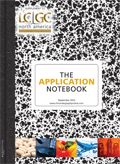Improved USP Chlorhexidine Gluconate Assay on YMCTriart C18 and YMC Meteoric Core HPLC Packing Materials
USP assay methods are widely used for quality control and stability testing.
USP assay methods are widely used for quality control and stability testing. Older methods can often be improved to take advantage of newer instrument design and column technologies. Improvements can include increases in sample throughput, method reproducibility, and solvent savings. This application note illustrates how run time and solvent consumption can be reduced when compared against the USP assay method for chlorhexidine gluconate.
The improved method is demonstrated on two different columns: YMC-Triart C18 (hybrid particle) and YMC-Meteoric Core C18 (core-shell particle).

Figure 1: YMC-Triart C18, Part number = TA12S03-1002WT.
Original USP Method Parameters
Detection: 239 nm
Column: 250 × 4.6 mm, base-deactivated 5 µm packing L1
Column Temp: 40 °C
Flow rate: 1.5 mL/min
Inj. Volume: 50 µL
Total Runtime: 21 min
Mobile Phase A: 0.1M NaH2PO4, 0.5% Triethylamine, pH=3.0
Mobile Phase B: Acetonitrile
Gradient: 0–9 min 0% B, 9–10 min 0–55% B, 10–15 min hold 55% B, 15–16 min 55–0% B, 16–21min hold 0% B
Resolution: NLT 3.0 between chlorhexidine and p-chloroaniline
Improved Method Parameters
Detection: 239 nm
Columns: Test done on two different columns: YMC-Triart C18, 3 µm, 2.0 × 100 mm YMC-Meteoric Core C18, 2.7 µm, 2.1 × 100 mm
Column Temp: 40 °C
Flow rate: 0.3 mL/min
Inj. Volume: 4 µL
Total Runtime: 8.8 min
Mobile Phase A: 0.1M NaH2PO4, 0.5% Triethylamine, pH=3.0
Mobile Phase B: Acetonitrile
Gradient: 0–3.6 min 0% B, 3.6–4 min 0–55% B, 4–6 min hold 55% B, 6–6.4 min 55–0% B, 6.4–8.5 min hold 0% B
Resolution: NLT 3.0 between chlorhexidine and p-chloroaniline (same as original method)
Results
Method Transfer Considerations: Scale-down for YMC L1 Packing Materials
- Injection volume was decreased to 4 µL due to changes in column I.D. and length
- Flow rate was decreased to 0.3 mL/min due to changes in column I.D.
- The gradient was adjusted to take into account the changes in flow rate, column I.D., and column length.
- Total run time for this method was reduced from 21 min to 8.8 min.
Separation with YMC-Triart C18
Highlights:
- Solvent usage for TA12S03-1002WT Method = (0.3 mL/min) × (8.8 min) = 2.64 mL per injection
- USP Resolution between CHX and pCA = 6.2
- USP Tailing CHX = 1.0
- USP Tailing pCA = 1.0
- Backpressure = 2570 psi
Separation with YMC-Meteoric Core C18
Highlights:
- Solvent usage for CAS08SQ7-10Q1PT Method = (0.3 mL/min) × (8.8 min) = 2.64 mL per injection
- USP Resolution between CHX and pCA = 8.5
- USP Tailing CHX = 1.1
- USP Tailing pCA = 1.0
- Backpressure = 2832 psi
Reproducibility
The method was repeated on both YMC-Triart and YMC-Meteoric Core for 25 consecutive injections each. Both types exhibit excellent reproducibility for peak shape and retention time. Space here does not allow illustration, but the details are available from YMC America.

Figure 2: YMC Meteoric Core, Part number = CAS08SQ7-10Q1PT.
Conclusions
YMC-Triart C18 and YMC Meteoric Core C18 columns exhibit the selectivity and reproducibility necessary to deliver meaningful improvements to the USP method. The smaller particle sizes, shorter column length, and smaller column inner diameter allow for a much faster method (1/3 the runtime) that uses 12× less solvent. The method also meets the original method's resolution requirements of NLT 3.0 without issue.

YMC America, Inc.
941 Marcon Blvd., Suite 201, Allentown, PA 18109
tel. (610) 266-8650, fax (610) 266-8652
Website: www.ymcamerica.com

SEC-MALS of Antibody Therapeutics—A Robust Method for In-Depth Sample Characterization
June 1st 2022Monoclonal antibodies (mAbs) are effective therapeutics for cancers, auto-immune diseases, viral infections, and other diseases. Recent developments in antibody therapeutics aim to add more specific binding regions (bi- and multi-specificity) to increase their effectiveness and/or to downsize the molecule to the specific binding regions (for example, scFv or Fab fragment) to achieve better penetration of the tissue. As the molecule gets more complex, the possible high and low molecular weight (H/LMW) impurities become more complex, too. In order to accurately analyze the various species, more advanced detection than ultraviolet (UV) is required to characterize a mAb sample.

.png&w=3840&q=75)

.png&w=3840&q=75)



.png&w=3840&q=75)



.png&w=3840&q=75)














